You must be wondering what Einstein has to do with the theme of our blog, Aranya Parva. The “Man of the Century”, Einstein, also wondered why he had to do anything with the ‘Bomb’! The stage was set, and we watched Albert Einstein in his study.
Saturday are always hectic in Bangalore, because of Rana’s theory (of relativity) – some of the IT folks who use office transport – bless them – own cars and need to use them. So they get the cars out on Saturday and strangle the Bangalore roads. Despite that, Saturdays can be great, like the one that just went by. We reached St. Joseph’s College auditorium, said a quick hello to our good friend, Poornima Kannan, who was ushering in the audience for the play Einstein: A stage portrait. Bangalore Little Theatre and Azim Premji University, in association with St. Joseph’s College, have brought this play to Bangalore.
The only thing missing was a glass of whiskey in our hands, because the whole experience felt like Einstein was sitting across the table, narrating the story of his life to us, in person. At the end of the play, it was hard to decide whom to appreciate better, the playwright or the artist. Williard Simms has woven the story of the Einstein in an intimate and riveting way, transporting us to a different world. The
playwright has drawn details from Einstein’s letters to his son and daughter-in-law, and has presented every relevant detail in the manner of an intimate conversation. From the days when Einstein chased butterflies (Poornima would have definitely loved this part of his life story), to the days when he wrote to Roosevelt, Simms gives us the many facets of Einstein’s character that we would hardly know about. The scientist was charming, witty, funny, sensitive, and maybe sometimes selfish, arrogant, and most important of all, humane.
When a playwright does such a fantastic job of characterization, an artist can only hope to do justice to the role. Tom Schuch does that, giving his everything to it, including his age. Delivering 46 pages of script is no mean feat, and to do that flawlessly with a slight hint of German accent takes not just dedication, but passion for one’s profession. Being a drama artist of All India Radio, and having had a brief stint with theatre/TV, I understand what goes behind portraying a role. All I can do is tell the artist, take a bow, for we stepped out of the auditorium with a feeling of having met the scientist himself. The reviews are spot on – that he is an actor’s actor and that this play is a “drama-logue” par excellence. Watch the trailer here. If you think the hair and make-up look awesome, listen to Tom laughing – I just loved it 😀
One of Einstein’s quotes says, “Look deep into nature, and then you will understand everything better”. This brings the connection to our blog. Watch the play to understand and appreciate the man’s connections with what was happening around him and his train of thoughts. When he talks relativity again and again, you can’t help but think of the various projects that are being done at such a rapid pace, with little thought on their impacts. Remember, Einstein also said this: “A human being is a part of the whole called by us universe, a part limited in time and space … Our task must be to free ourselves from this prison by widening our circle of compassion to embrace all living creatures and the whole of nature in its beauty.”
 There are different shows scheduled for specific audiences across Bangalore. If you know it is scheduled in your organization, be there half an hour early 😉 Wherever in the world you are, if you hear about this play by Spoli Productions International in your locality, don’t miss it! There is an additional bonus at the end of the play – a question and answer session with the actor and the playwright. Ask away and enjoy 🙂
There are different shows scheduled for specific audiences across Bangalore. If you know it is scheduled in your organization, be there half an hour early 😉 Wherever in the world you are, if you hear about this play by Spoli Productions International in your locality, don’t miss it! There is an additional bonus at the end of the play – a question and answer session with the actor and the playwright. Ask away and enjoy 🙂
Sugandhi

















